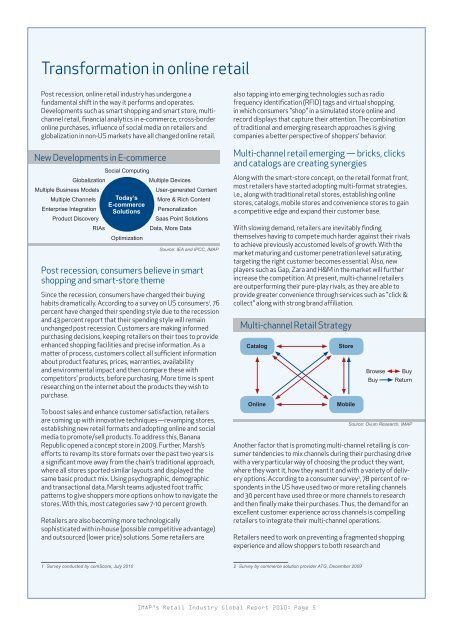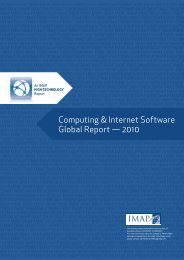Retail industry global report 2010.pdf - IMAP
Retail industry global report 2010.pdf - IMAP
Retail industry global report 2010.pdf - IMAP
- No tags were found...
You also want an ePaper? Increase the reach of your titles
YUMPU automatically turns print PDFs into web optimized ePapers that Google loves.
Transformation in online retailPost recession, online retail <strong>industry</strong> has undergone afundamental shift in the way it performs and operates.Developments such as smart shopping and smart store, multichannelretail, financial analytics in e-commerce, cross-borderonline purchases, influence of social media on retailers and<strong>global</strong>ization in non-US markets have all changed online retail.New Developments in E-commerceGlobalizationMultiple Business ModelsMultiple ChannelsEnterprise IntegrationProduct DiscoveryRIAsSocial ComputingToday’sE-commerceSolutionsOptimizationMultiple DevicesUser-generated ContentMore & Rich ContentPersonalizationSaas Point SolutionsData, More DataSource: IEA and IPCC, <strong>IMAP</strong>Post recession, consumers believe in smartshopping and smart-store themeSince the recession, consumers have changed their buyinghabits dramatically. According to a survey on US consumers 1 , 76percent have changed their spending style due to the recessionand 43 percent <strong>report</strong> that their spending style will remainunchanged post recession. Customers are making informedpurchasing decisions, keeping retailers on their toes to provideenhanced shopping facilities and precise information. As amatter of process, customers collect all sufficient informationabout product features, prices, warranties, availabilityand environmental impact and then compare these withcompetitors’ products, before purchasing. More time is spentresearching on the internet about the products they wish topurchase.To boost sales and enhance customer satisfaction, retailersare coming up with innovative techniques—revamping stores,establishing new retail formats and adopting online and socialmedia to promote/sell products. To address this, BananaRepublic opened a concept store in 2009. Further, Marsh’sefforts to revamp its store formats over the past two years isa significant move away from the chain’s traditional approach,where all stores sported similar layouts and displayed thesame basic product mix. Using psychographic, demographicand transactional data, Marsh teams adjusted foot trafficpatterns to give shoppers more options on how to navigate thestores. With this, most categories saw 7-10 percent growth.<strong>Retail</strong>ers are also becoming more technologicallysophisticated with in-house (possible competitive advantage)and outsourced (lower price) solutions. Some retailers arealso tapping into emerging technologies such as radiofrequency identification (RFID) tags and virtual shopping,in which consumers "shop" in a simulated store online andrecord displays that capture their attention. The combinationof traditional and emerging research approaches is givingcompanies a better perspective of shoppers’ behavior.Multi-channel retail emerging — bricks, clicksand catalogs are creating synergiesAlong with the smart-store concept, on the retail format front,most retailers have started adopting multi-format strategies,i.e., along with traditional retail stores, establishing onlinestores, catalogs, mobile stores and convenience stores to gaina competitive edge and expand their customer base.With slowing demand, retailers are inevitably findingthemselves having to compete much harder against their rivalsto achieve previously accustomed levels of growth. With themarket maturing and customer penetration level saturating,targeting the right customer becomes essential. Also, newplayers such as Gap, Zara and H&M in the market will furtherincrease the competition. At present, multi-channel retailersare outperforming their pure-play rivals, as they are able toprovide greater convenience through services such as "click &collect" along with strong brand affiliation.Multi-channel <strong>Retail</strong> StrategyCatalogOnlineStoreMobileBrowseBuySource: Ovum Research, <strong>IMAP</strong>Another factor that is promoting multi-channel retailing is consumertendencies to mix channels during their purchasing drivewith a very particular way of choosing the product they want,where they want it, how they want it and with a variety of deliveryoptions. According to a consumer survey 2 , 78 percent of respondentsin the US have used two or more retailing channelsand 30 percent have used three or more channels to researchand then finally make their purchases. Thus, the demand for anexcellent customer experience across channels is compellingretailers to integrate their multi-channel operations.<strong>Retail</strong>ers need to work on preventing a fragmented shoppingexperience and allow shoppers to both research andBuyReturn1 Survey conducted by comScore, July 20102 Survey by commerce solution provider ATG, December 2009<strong>IMAP</strong>’s <strong>Retail</strong> Industry Global Report 2010: Page 5








